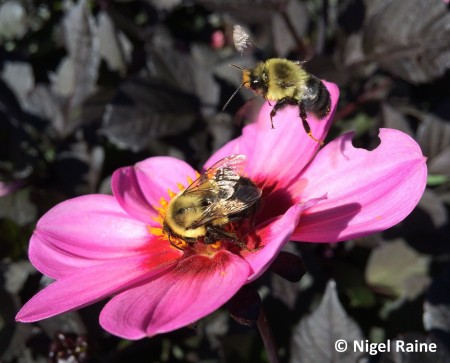Experienced bumblebees prefer not to share their foraging knowledge with newbies, according to new research involving a University of Guelph professor.
The study by environmental sciences professor Nigel Raine and researchers at Queen Mary University of London (QMUL) was published March 16 in the journal PLoS One.
 “Understanding how bees find and compete for flowers in the landscape is a critical first step to conserving these insects and the essential pollination services they provide to crops and wild plants,” said Raine, who holds the Rebanks Family Chair in Pollinator Conservation.
“Understanding how bees find and compete for flowers in the landscape is a critical first step to conserving these insects and the essential pollination services they provide to crops and wild plants,” said Raine, who holds the Rebanks Family Chair in Pollinator Conservation.
This is the second study Raine has published this week involving bumblebees.
Like other pollinators, bees face complex routing challenges when collecting nectar and pollen. This includes learning how to link patches of flowers together in the most efficient way to minimize travel and distance, the study said.
Figuring out an optimal route takes time and experience. The researchers wondered whether bees copy others’ flower visitation sequences in the field to improve their foraging,
“Our study is the first to examine the foraging routes followed by multiple bees at the same time,” said lead author Mathieu Lihoreau, formerly with QMUL and now at the Centre National de la Recherche Scientifique-University of Toulouse.
Lars Chittka, a QMUL professor and co-author, added: “We wanted to monitor the way bumblebees behave when they bump into each other at flowers — would they compete, attack each other or tolerate each other.”
The team set up a 20- by 40-metre outdoor flight cage, one of the largest ever used in bee research.
They installed a range of artificial flowers, fitted with motion-sensitive video cameras and controlled nectar flow rates, for the bees to visit.
Two bees were allowed to visit the flowers at a time – one more experienced resident and one newcomer.
When the newcomer bees tried to copy the choices of seasoned foragers, the more experienced bees frequently attacked them and tried to evict them from flowers.
Responses to intense initial competition between bees for nectar could explain how pollinators gradually learn to visit different patches of flowers across the landscape, the study said.
“This work helps us understand how animals with relatively simple brains find workable solutions to complex route-finding problems,” Raine said.